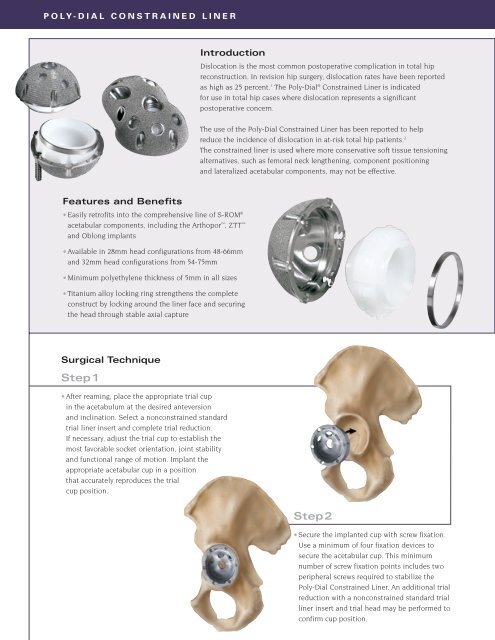Poly-Dial®
Poly-Dial®
Poly-Dial®
You also want an ePaper? Increase the reach of your titles
YUMPU automatically turns print PDFs into web optimized ePapers that Google loves.
POLY-DIAL CONSTRAINED LINER<br />
Features and Benefits<br />
Introduction<br />
• Easily retrofits into the comprehensive line of S-ROM ®<br />
acetabular components, including the Arthopor , ZTT <br />
and Oblong implants<br />
• Available in 28mm head configurations from 48-66mm<br />
and 32mm head configurations from 54-75mm<br />
• Minimum polyethylene thickness of 5mm in all sizes<br />
• Titanium alloy locking ring strengthens the complete<br />
construct by locking around the liner face and securing<br />
the head through stable axial capture<br />
Surgical Technique<br />
Step1<br />
• After reaming, place the appropriate trial cup<br />
in the acetabulum at the desired anteversion<br />
and inclination. Select a nonconstrained standard<br />
trial liner insert and complete trial reduction.<br />
If necessary, adjust the trial cup to establish the<br />
most favorable socket orientation, joint stability<br />
and functional range of motion. Implant the<br />
appropriate acetabular cup in a position<br />
that accurately reproduces the trial<br />
cup position.<br />
Dislocation is the most common postoperative complication in total hip<br />
reconstruction. In revision hip surgery, dislocation rates have been reported<br />
as high as 25 percent. 1 The <strong>Poly</strong>-Dial ® Constrained Liner is indicated<br />
for use in total hip cases where dislocation represents a significant<br />
postoperative concern.<br />
The use of the <strong>Poly</strong>-Dial Constrained Liner has been reported to help<br />
reduce the incidence of dislocation in at-risk total hip patients. 2<br />
The constrained liner is used where more conservative soft tissue tensioning<br />
alternatives, such as femoral neck lengthening, component positioning<br />
and lateralized acetabular components, may not be effective.<br />
Step2<br />
• Secure the implanted cup with screw fixation.<br />
Use a minimum of four fixation devices to<br />
secure the acetabular cup. This minimum<br />
number of screw fixation points includes two<br />
peripheral screws required to stabilize the<br />
<strong>Poly</strong>-Dial Constrained Liner. An additional trial<br />
reduction with a nonconstrained standard trial<br />
liner insert and trial head may be performed to<br />
confirm cup position.



